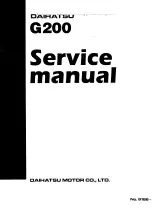
Steps for Determining Correct Load Limit
1.
Locate the statement
“
The combined weight
of occupants and cargo should never exceed
XXX kg or XXX lbs
”
on your vehicle's placard.
2.
Determine the combined weight of the driver
and passengers that will be riding in your
vehicle.
3.
Subtract the combined weight of the driver
and passengers from XXX kg or XXX lbs.
4.
The resulting figure equals the available
amount of cargo and luggage load capacity.
For example, if the
“
XXX
”
amount equals
1400 lbs and there will be five 150 lb
passengers in your vehicle, the amount of
available cargo and luggage load capacity is
650 lbs (1400
−
750 (5 x 150) = 650 lbs).
5.
Determine the combined weight of luggage
and cargo being loaded on the vehicle. That
weight may not safely exceed the available
cargo and luggage load capacity calculated in
Step 4.
6.
If your vehicle will be towing a trailer, the load
from your trailer will be transferred to your
vehicle. Consult this manual to determine
how this reduces the available cargo and
luggage load capacity of your vehicle.
See
Towing a Trailer on page 5
‑
46
for
important information on towing a trailer,
towing safety, and trailering tips.
5-33
Summary of Contents for 2010 Colorado
Page 6: ...2 NOTES vi ...
Page 8: ...Instrument Panel Manual Transmission shown Automatic Transmission similar 1 2 ...
Page 30: ...2 NOTES 1 24 ...
Page 46: ...Put someone on it Get it up to speed Then stop the vehicle The rider does not stop 2 16 ...
Page 114: ...2 NOTES 2 84 ...
Page 222: ...2 NOTES 4 62 ...
Page 294: ...When you open the hood on the 5 3L engine you will see the following 6 14 ...
Page 394: ...6 114 ...
Page 413: ...Engine Drive Belt Routing 2 9L and 3 7L Engines 5 3L Engine 7 13 ...
Page 415: ...Maintenance Record cont d Date Odometer Reading Serviced By Services Performed 7 15 ...
Page 416: ...Maintenance Record cont d Date Odometer Reading Serviced By Services Performed 7 16 ...
















































